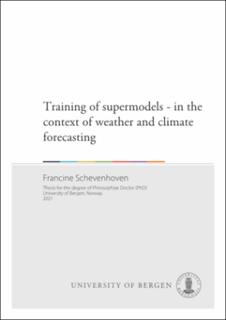| dc.contributor.author | Schevenhoven, Francine | |
| dc.date.accessioned | 2021-02-11T13:03:28Z | |
| dc.date.available | 2021-02-11T13:03:28Z | |
| dc.date.issued | 2021-02-08 | |
| dc.date.submitted | 2021-01-13T13:41:10.839Z | |
| dc.identifier | container/fa/68/7d/59/fa687d59-d19e-4450-8bcd-edd7d7f3398f | |
| dc.identifier.isbn | 9788230852422 | |
| dc.identifier.isbn | 9788230852743 | |
| dc.identifier.uri | https://hdl.handle.net/11250/2727454 | |
| dc.description.abstract | Given a set of imperfect weather or climate models, predictions can be improved by combining the models dynamically into a so called `supermodel'. The models are optimally combined to compensate their individual errors. This is different from the standard multi-model ensemble approach (MME), where the model output is statistically combined after the simulations. Instead, the supermodel can create a trajectory closer to observations than any of the imperfect models. By intervening during the forecast, errors can be reduced at an early stage and the ensemble can exhibit different dynamical behavior than any of the individual models. In this way, common errors between the models can be removed and new, physically correct behavior can appear.
In our simplified context of models sharing the same evolution function and phase space, we can define either a connected or a weighted supermodel. A connected supermodel uses nudging to bring the models closer together, while in a weighted supermodel all model states are replaced at regular time intervals (i.e., restarted) by the weighted average of the individual model states. To obtain optimal connection coefficients or weights, we need to train the supermodel on the basis of historical observations. A standard training approach such as minimization of a cost function requires many model simulations, which is computationally very expensive. This thesis has focused on developing two new methods to efficiently train supermodels. The first method is based on an idea called cross pollination in time, where models exchange states during the training. The second method is a synchronization-based learning rule, originally developed for parameter estimation.
The techniques are developed on low-order systems, such as Lorenz63, and later applied to different versions of the intermediate-complexity global coupled atmosphere-ocean-land model SPEEDO. Here the observations are from the same models, but with different parameters. The applicability of the method to real observations is tested using sensitivity to noisy and incomplete data. The characteristics the individual models should have in order to be combined together into a supermodel are identified, as well as which physical variables should be connected in a supermodel, and which ones should not. Both training methods result in supermodels that outperform both the individual models and the MME, for short term predictions as well as long term simulations. Furthermore, we show that the novel use of negative weights can improve predictions in cases where model errors do not cancel (for instance, all models are too warm with respect to the truth). A crucial advantage of the proposed training schemes is that in the present context relatively short training periods suffice to find good solutions. Although the validity of our conclusions in the context of real observations and model scenarios has yet to be proved, our results are very encouraging. In principle, the methods are suitable to train supermodels constructed using state-of-the art weather and climate models. | en_US |
| dc.language.iso | eng | en_US |
| dc.publisher | The University of Bergen | en_US |
| dc.relation.haspart | Paper I: Schevenhoven, F. J., and F. M. Selten, (2017), An efficient training scheme for supermodels, Earth System Dynamics, 8(2), 429-438. The article is available at: <a href=" https://hdl.handle.net/1956/18396" target="blank"> https://hdl.handle.net/1956/18396</a> | en_US |
| dc.relation.haspart | Paper II: Selten, F. M., F. J. Schevenhoven, and G. S. Duane, (2017), Simulating climate with a synchronization-based supermodel, Chaos: An Interdisciplinary Journal of Nonlinear Science, 27(12), 126,903. The article is available at: <a href=" https://hdl.handle.net/1956/18589" target="blank"> https://hdl.handle.net/1956/18589</a> | en_US |
| dc.relation.haspart | Paper III: Schevenhoven, F., F. Selten, A. Carrassi, and N. Keenlyside, (2019), Improving weather and climate predictions by training of supermodels, Earth System Dynamics, 10(4), 789-807. The article is available at: <a href="https://hdl.handle.net/1956/23627" target="blank">https://hdl.handle.net/1956/23627</a> | en_US |
| dc.relation.haspart | Paper IV: Schevenhoven, F., and A. Carrassi, Training supermodels with noisy and sparse Observations. The article is not available in BORA. | en_US |
| dc.relation.haspart | Paper V: Schevenhoven, F., and H. Du, A comparison of different approaches to combine models dynamically. The article is not available in BORA. | en_US |
| dc.rights | Copyright the Author. All rights reserved | |
| dc.title | Training of supermodels - in the context of weather and climate forecasting | en_US |
| dc.type | Doctoral thesis | en_US |
| dc.date.updated | 2021-01-13T13:41:10.839Z | |
| dc.rights.holder | Copyright the Author. | en_US |
| dc.description.degree | Doktorgradsavhandling | |
| fs.unitcode | 12-44-0 | |
